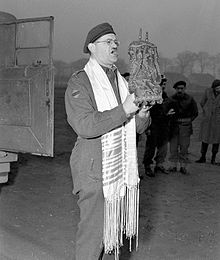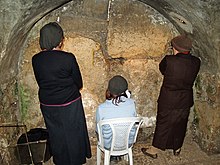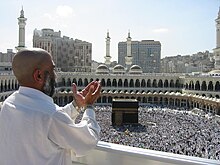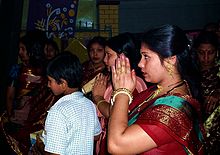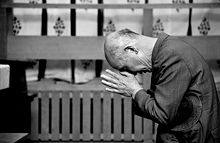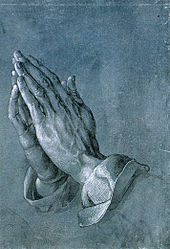Prayer

Prayer is a form of religious practice that seeks to activate a volitional rapport to a god or spirit through deliberate practice. Prayer may be either individual or communal and take place in public or in private. It may involve the use of words or song. When language is used, prayer may take the form of a hymn, incantation, formal creed, or a spontaneous utterance in the praying person. There are different forms of prayer such as petitionary prayer, prayers of supplication, thanksgiving, and worship/praise. Prayer may be directed towards a deity, spirit, deceased person, or lofty idea, for the purpose of worshipping, requesting guidance, requesting assistance, confessing sins or to express one's thoughts and emotions. Thus, people pray for many reasons such as personal benefit or for the sake of others.
Most major religions involve prayer in one way or another. Some ritualize the act of prayer, requiring a strict sequence of actions or placing a restriction on who is permitted to pray, while others teach that prayer may be practiced spontaneously by anyone at any time.
Scientific studies regarding the use of prayer have mostly concentrated on its effect on the healing of sick or injured people. The efficacy of petition in prayer for physical healing to a deity has been evaluated in numerous studies, with contradictory results.[1][2][3][4] There has been some criticism of the way the studies were conducted.[5][6]
Contents[hide] |
[edit] Forms of prayer

Various spiritual traditions offer a wide variety of devotional acts. There are morning and evening prayers, graces said over meals, and reverent physical gestures. Some Christians bow their heads and fold their hands. Some Native Americans regard dancing as a form of prayer.[7] Some Sufis whirl.[8] Hindus chant mantras.[9] Orthodox Jews sway their bodies back and forth[10] and Salah for Muslims ("kneel and prostrate as seen on the right"). Quakers keep silent.[11] Some pray according to standardized rituals and liturgies, while others prefer extemporaneous prayers. Still others combine the two.
These methods show a variety of understandings to prayer, which are led by underlying beliefs.
These beliefs may be that
- the finite can communicate with the infinite
- the infinite is interested in communicating with the finite
- prayer is intended to inculcate certain attitudes in the one who prays, rather than to influence the recipient
- prayer is intended to train a person to focus on the recipient through philosophy and intellectual contemplation
- prayer is intended to enable a person to gain a direct experience of the recipient
- prayer is intended to affect the very fabric of reality as we perceive it
- prayer is a catalyst for change in oneself and/or one's circumstances, or likewise those of third party beneficiaries
- the recipient desires and appreciates prayer
- or any combination of these.[citation needed]
The act of prayer is attested in written sources as early as 5000 years ago.[12] Some anthropologists, such as Sir Edward Burnett Tylor and Sir James George Frazer, believed that the earliest intelligent modern humans practiced something that we would recognize today as prayer.[13]
Friedrich Heiler is often cited in Christian circles for his systematic Typology of Prayer which lists six types of prayer: primitive, ritual, Greek cultural, philosophical, mystical, and prophetic.[14]
[edit] The act of worship
Prayer has many different forms. Prayer may be done privately and individually, or it may be done corporately in the presence of fellow believers. Prayer can be incorporated into a daily "thought life", in which one is in constant communication with a god. Some people pray throughout all that is happening during the day and seek guidance as the day progresses. This is actually regarded as a requirement in several Christian denominations,[15] although enforcement is not possible nor desirable. There can be many different answers to prayer, just as there are many ways to interpret an answer to a question, if there in fact comes an answer.[15] Some may experience audible, physical, or mental epiphanies. If indeed an answer comes, the time and place it comes is considered random. Some outward acts that sometimes accompany prayer are: anointing with oil;[16] ringing a bell;[17] burning incense or paper;[18] lighting a candle or candles;[19] facing a specific direction (i.e. towards Mecca[20] or the East); making the sign of the cross. one less noticeable act related to prayer is fasting.
A variety of body postures may be assumed, often with specific meaning (mainly respect or adoration) associated with them: standing; sitting; kneeling; prostrate on the floor; eyes opened; eyes closed; hands folded or clasped; hands upraised; holding hands with others; a laying on of hands and others. Prayers may be recited from memory, read from a book of prayers, or composed spontaneously as they are prayed. They may be said, chanted, or sung. They may be with musical accompaniment or not. There may be a time of outward silence while prayers are offered mentally. Often, there are prayers to fit specific occasions, such as the blessing of a meal, the birth or death of a loved one, other significant events in the life of a believer, or days of the year that have special religious significance. Details corresponding to specific traditions are outlined below.
[edit] Pre-Christian Europe
[edit] Etruscan, Greek, and Roman paganism
In the pre-Christian religions of Greeks and Romans (Ancient Greek religion, Roman religion), ceremonial prayer was highly formulaic and ritualized.[21][22] The Iguvine Tables contain a supplication that can be translated, "If anything was said improperly, if anything was done improperly, let it be as if it were done correctly."
The formalism and formulaic nature of these prayers led them to be written down in language that may have only been partially understood by the writer, and our texts of these prayers may in fact be garbled. Prayers in Etruscan were used in the Roman world by augurs and other oracles long after Etruscan became a dead language. The Carmen Arvale and the Carmen Saliare are two specimens of partially preserved prayers that seem to have been unintelligible to their scribes, and whose language is full of archaisms and difficult passages.[23]
Roman prayers and sacrifices were often envisioned as legal bargains between deity and worshipper. The Roman principle was expressed as do ut des: "I give, so that you may give." Cato the Elder's treatise on agriculture contains many examples of preserved traditional prayers; in one, a farmer addresses the unknown deity of a possibly sacred grove, and sacrifices a pig in order to placate the god or goddess of the place and beseech his or her permission to cut down some trees from the grove.[24]
[edit] Germanic paganism
An amount of accounts of prayers to the gods in Germanic paganism survived the process of Christianization, though only a single prayer has survived without the interjection of Christian references. This prayer is recorded in stanzas 2 and 3 of the poem Sigrdrífumál, compiled in the 13th century Poetic Edda from earlier traditional sources, where the valkyrie Sigrdrífa prays to the gods and the earth after being woken by the hero Sigurd.[25]
A prayer to the bigger god Odin is mentioned in chapter 2 of the Völsunga saga where King Rerir prays for a child. His prayer is answered by Frigg, wife of Odin, who sends him an apple, which is dropped on his lap by Frigg's servant in the form of a crow while Rerir is sitting on a mound. Rerir's wife eats the apple and is then pregnant with the hero Völsung. In stanza 9 of the poem Oddrúnargrátr, a prayer is made to "kind wights, Frigg and Freyja, and many gods," although since the poem is often considered one of the youngest poems in the Poetic Edda, the passage has been the matter of some debate.[26]
In chapter 21 of Jómsvíkinga saga, wishing to turn the tide of the Battle of Hjörungavágr, Haakon Sigurdsson eventually finds his prayers answered by the goddesses Þorgerðr Hölgabrúðr and Irpa (the first of the two described as Haakon's patron goddess) who appear in the battle, kill many of the opposing fleet, and cause the remnants of their forces to flee. However, this depiction of a pagan prayer has been criticized as inaccurate due to the description of Haakon dropping to his knees.[27]
The 11th century manuscript for the Anglo-Saxon charm Æcerbot presents what is thought to be an originally pagan prayer for the fertility of the speaker's crops and land, though Christianization is apparent throughout the charm.[28] The 8th century Wessobrunn Prayer has been proposed as a Christianized pagan prayer and compared to the pagan Völuspá[29] and the Merseburg Incantations, the latter recorded in the 9th or 10th century but of much older traditional origins.[30]
[edit] Abrahamic religions
[edit] Bible
In the common Bible of the Abrahamic religions, various forms of prayer appear; the most common forms being petition, thanksgiving, and worship. The longest book in the Bible is the Book of Psalms, 150 religious songs which are often regarded as prayers. Other well-known Biblical prayers include the Song of Moses (Exodus 15:1-18), the Song of Hannah (1 Samuel 2:1-10), and the Magnificat (Luke 1:46-55). But perhaps the best-known prayer in the Christian Bible is the Lord's Prayer (Matthew 6:9–13; Luke 11:2-4).
[edit] Judaism
Jews pray three times a day, with lengthier prayers on special days, such as the Shabbat and Jewish holidays. The siddur is the prayerbook used by Jews all over the world, containing a set order of daily prayers. Jewish prayer is usually described as having two aspects: kavanah (intention) and keva (the ritualistic, structured elements).
The most important Jewish prayers are the Shema Yisrael ("Hear O Israel") and the Amidah ("the standing prayer").
Communal prayer is preferred over solitary prayer, and a quorum of 10 adult males (a minyan) is considered by Orthodox Judaism a prerequisite for several communal prayers.
[edit] Rationalist approach to prayer
In this view, ultimate goal of prayer is to help train a person to focus on divinity through philosophy and intellectual contemplation. This approach was taken by Maimonides and the other medieval rationalists. one example of this approach to prayer is noted by Rabbi Steven Weil, who was appointed the Orthodox Union's Executive-Vice President in 2009. He notes that the word “prayer” is a derivative of the Latin “precari”, which means “to beg”. The Hebrew equivalent “tefilah”, however, along with its root “pelel” or its reflexive “l’hitpallel”, means the act of self-analysis or self-evaluation.[31] This approach is sometimes described as the person praying having a dialogue or conversation with God.[32]
[edit] Educational approach to prayer
In this view, prayer is not a conversation. Rather, it is meant to inculcate certain attitudes in the one who prays, but not to influence. This has been the approach of Rabbenu Bachya, Yehuda Halevy, Joseph Albo, Samson Raphael Hirsch, and Joseph Dov Soloveitchik. This view is expressed by Rabbi Nosson Scherman in the overview to the Artscroll Siddur (p. XIII); note that Scherman goes on to also affirm the Kabbalistic view (see below).
[edit] Kabbalistic approach to prayer
Kabbalah (Jewish mysticism) uses a series of kavanot, directions of intent, to specify the path the prayer ascends in the dialog with God, to increase its chances of being answered favorably. Kabbalists ascribe a higher meaning to the purpose of prayer, which is no less than affecting the very fabric of reality itself, restructuring and repairing the universe in a real fashion. In this view, every word of every prayer, and indeed, even every letter of every word, has a precise meaning and a precise effect. Prayers thus literally affect the mystical forces of the universe, and repair the fabric of creation.[33]
Among Jews, this approach has been taken by the Chassidei Ashkenaz (German pietists of the Middle-Ages), the Arizal's Kabbalist tradition, Ramchal, most of Hassidism, the Vilna Gaon, and Jacob Emden.
[edit] Christianity

Christian prayers are quite varied. They can be completely spontaneous, or read entirely from a text, like the Anglican Book of Common Prayer. Probably the most common and universal prayer among Christians is the Lord's Prayer, which according to the gospel accounts is how Jesus taught his disciples to pray. Some Protestant denominations choose not to recite the Lord's Prayer or other rote prayers.
Christians generally pray to God or to the Father. Some Christians (e.g., Catholics, Orthodox) will also ask the righteous in heaven and "in Christ," such as Virgin Mary or other saints to intercede by praying on their behalf (intercession of saints). Formulaic closures include "through our Lord Jesus Christ, Your Son, who lives and reigns with You, in the unity of the Holy Spirit, God, through all the ages of ages," and "in the name of the Father, and the Son, and the Holy Spirit."
It is customary among Protestants to end prayers with "In Jesus' name, Amen" or "In the name of Christ, Amen"[34] However, the most commonly used closure in Christianity is simply "Amen" (from a Hebrew adverb used as a statement of affirmation or agreement, usually translated as so be it).
There is also the form of prayer called hesychast which is a repetitious type of prayer for the purpose of meditation. In the Western or Latin Rite of Catholic Church, probably the most common is the Rosary; In the Eastern Church (the Eastern rites of the Catholic Church and Orthodox Church), the Jesus Prayer.
Roman Catholic tradition includes specific prayers and devotions as acts of reparation which do not involve a petition for a living or deceased beneficiary, but aim to repair the sins of others, e.g. for the repair of the sin of blasphemy performed by others.[35]
[edit] Pentecostalism
In Pentecostal congregations, prayer is often done by speaking in a foreign tongue, a practice now known as glossolalia.[36] Practitioners of Pentecostal glossolalia may claim that the languages they speak in prayer are real foreign languages, and that the ability to speak those languages spontaneously is a gift of the Holy Spirit;[37][38] however, many people outside the movement have offered alternative views. George Barton Cutten suggested that glossolalia was a sign of mental illness.[39] Felicitas Goodman suggested that tongue speakers were under a form of hypnosis.[40] Others suggest that it is a learned behaviour.[41][42] Some of these views have allegedly been refuted.[43][44]
[edit] Christian Science
Christian Science teaches that prayer is a spiritualization of thought or an understanding of God and of the nature of the underlying spiritual creation. Adherents believe that this can result in healing, by bringing spiritual reality (the "Kingdom of Heaven" in Biblical terms) into clearer focus in the human scene. The world as it appears to the senses is regarded as a distorted version of the world of spiritual ideas. Prayer can heal the distortion. Christian Scientists believe that prayer does not change the spiritual creation but gives a clearer view of it, and the result appears in the human scene as healing: the human picture adjusts to coincide more nearly with the divine reality. Christian Scientists do not practice intercessory prayer as it is commonly understood, and they generally avoid combining prayer with medical treatment in the belief that the two practices tend to work against each other. (However, the choice of healing method is regarded as a matter for the individual, and the Christian Science Church exerts no pressure on members to avoid medical treatment if they wish to avail of it as an alternative to Christian Science healing.) Prayer works through love: the recognition of God's creation as spiritual, intact, and inherently lovable.[45]
[edit] Prevalence of prayer for health
Some modalities of alternative medicine employ prayer. A survey released in May 2004 by the National Center for Complementary and Alternative Medicine, part of the National Institutes of Health in the United States, found that in 2002, 43% of Americans pray for their own health, 24% pray for others' health, and 10% participate in a prayer group for their own health.
[edit] Islam

Muslims pray a ritualistic prayer called salah or salat in Arabic, facing the Kaaba in Mecca, five times a day. The command to pray is in the Quran in several chapters. The prophet Muhammed showed each Muslim the true method of offering prayers thus the same method is observed till date. There is the "call for prayer" (adhan or azaan), where the muezzin calls for all the followers to stand together for the prayer. The prayer consists of standing, by mentioning -àllàh o -àqbàr (God is great) followed by recitation of the first chapter of the Quran. After the person bends and praises god, then prostrates and again praises god. The prayer ends with the following words "peace and blessings be upon you". During the prayer a Muslim cannot talk or do anything else besides praying. once the prayer is complete one can offer voluntary prayers or supplicate -àllàh for his needs. There are also many standard duas or supplications, also in Arabic, to be recited at various times, e.g. for one's parents, after salah, before eating. Muslims may also say dua in their own words and languages for any issue they wish to communicate with God in the hope that God will answer their prayers.[20] Certain Shia fiqhs pray 3 times a day.[46]
[edit] Bahá'í
Bahá'u'lláh, the Báb, and `Abdu'l-Bahá have revealed many prayers for general use, and some for specific occasions, including for unity, detachment, spiritual upliftment, and healing among others. Bahá'ís are also required to recite each day one of three obligatory prayers revealed by Bahá'u'lláh. The believers have been enjoined to face in the direction of the Qiblih when reciting their Obligatory Prayer. The longest obligatory prayer may be recited at any time during the day; another, of medium length, is recited once in the morning, once at midday, and once in the evening; and the shortest can be recited anytime between noon and sunset. Bahá'ís also read from and meditate on the scriptures every morning and evening.[47]
[edit] Eastern religions
In contrast with Western religion, Eastern religion for the most part discards worship and places devotional emphasis on the practice of meditation alongside scriptural study. Consequently, prayer is seen as a form of meditation or an adjunct practice to meditation.[citation needed]
[edit] Buddhism
In certain Buddhist sects, prayer accompanies meditation. Buddhism for the most part sees prayer as a secondary, supportive practice to meditation and scriptural study. Gautama Buddha claimed that human beings possess the capacity and potential to be liberated, or enlightened, through contemplation, leading to insight. Prayer is seen mainly as a powerful psycho-physical practice that can enhance meditation.[48]
In the earliest Buddhist tradition, the Theravada, and in the later Mahayana tradition of Zen (or Chán), prayer plays only an ancillary role. It is largely a ritual expression of wishes for success in the practice and in helping all beings.[49][50][51][52]
The skillful means (Sanskrit: upaya) of the transfer of merit (Sanskrit: parinamana) is an evocation and prayer. Moreover, indeterminate buddhas are available for intercession as they reside in awoken-fields (Sanskrit: buddha-kshetra).
The nirmanakaya of a awoken-field is what is generally known and understood as mandala. The opening and closing of the ring (Sanskrit: mandala) is an active prayer. An active prayer is a mindful activity, an activity in which mindfulness is not just cultivated but is.[53] A common prayer is "May the merit of my practice, adorn Buddhas' Pure Lands, requite the fourfold kindness from above, and relieve the suffering of the three life-journeys below. Universally wishing sentient beings, Friends, foes, and karmic creditors, all to activate the bodhi mind, and all to be reborn in the Pure Land of Ultimate Bliss." (願以此功德 莊嚴佛淨土 上報四重恩 下濟三途苦 普願諸眾生 冤親諸債主 悉發菩提心 同生極樂國)[54]
The Generation Stage (Sanskrit: utpatti-krama) of Vajrayana involves prayer elements.[55]
The Tibetan Buddhism tradition emphasizes an instructive and devotional relationship to a guru; this may involve devotional practices known as guru yoga which are congruent with prayer. It also appears that Tibetan Buddhism posits the existence of various deities, but the peak view of the tradition is that the deities or yidam are no more existent or real than the continuity (Sanskrit: santana; refer mindstream) of the practitioner, environment and activity. But how practitioners engage yidam or tutelary deities will depend upon the level or more appropriately yana at which they are practicing. At one level, one may pray to a deity for protection or assistance, taking a more subordinate role. At another level, one may invoke the deity, on a more equal footing. And at a higher level one may deliberately cultivate the idea that one has become the deity, whilst remaining aware that its ultimate nature is shunyata. The views of the more esoteric yana are impenetrable for those without direct experience and empowerment.
Pure Land Buddhism emphasizes the recitation by devotees of prayer-like mantras, a practice often called Nembutsu.[56]:190 on one level it is said that reciting these mantras can ensure rebirth into a sambhogakaya land (Sanskrit: buddha-kshetra) after bodily dissolution, a sheer ball spontaneously co-emergent to a buddha's enlightened intention. According to Shinran, the founder of the Pure Land Buddhism tradition that is most prevalent in the US[56]:193[57] "for the long haul nothing is as efficacious as the Nembutsu."[56]:197[58] on another, the practice is a form of meditation aimed at achieving realization.[citation needed]
But beyond all these practices the Buddha emphasized the primacy of individual practice and experience. He said that supplication to gods or deities was not necessary. Nevertheless, today many lay people in East Asian countries pray to the Buddha in ways that resemble Western prayer—asking for intervention and offering devotion.
[edit] Hinduism
Hinduism has incorporated many kinds of prayer (Sanskrit: prārthanā), from fire-based rituals to philosophical musings. While chanting involves 'by dictum' recitation of timeless verses or verses with timings and notations, dhyanam involves deep meditation (however short or long) on the preferred deity/God. Again the object to which prayers are offered could be a persons referred as devtas, trinity or incarnation of either devtas or trinity or simply plain formless meditation as practiced by the ancient sages. All of these are directed to fulfilling personal needs or deep spiritual enlightenment. Ritual invocation was part and parcel of the Vedic religion and as such permeated their sacred texts. Indeed, the highest sacred texts of the Hindus, the Vedas, are a large collection of mantras and prayer rituals. Classical Hinduism came to focus on extolling a single supreme force, Brahman, that is made manifest in several lower forms as the familiar gods of the Hindu pantheon[dubious ]. Hindus in India have numerous devotional movements. Hindus may pray to the highest absolute God Brahman, or more commonly to Its three manifestations namely creator god called Brahma, preserver god called Vishnu and destroyer god (so that the creation cycle can start afresh) Shiva, and at the next level to Vishnu's avatars (earthly appearances) Rama and Krishna or to many other male or female deities. Typically, Hindus pray with their hands (the palms) joined together in pranam. The hand gesture is similar to the popular Indian greeting namaste.
[edit] Jainism
Although Jains believe that no spirit or divine being can assist them on their path, they do hold some influence, and on special occasions, Jains will pray for right knowledge to the twenty-four Tirthankaras (saintly teachers) or sometimes to Hindu deities such as Ganesha.
[edit] Shinto
The practices involved in Shinto prayer are heavily influenced by Buddhism; Japanese Buddhism has also been strongly influenced by Shinto in turn. The most common and basic form of devotion involves throwing a coin, or several, into a collection box, ringing a bell, clapping one's hands, and contemplating one's wish or prayer silently. The bell and hand clapping are meant to wake up or attract the attention of the kami of the shrine, so that one's prayer may be heard.
Shinto prayers quite frequently consist of wishes or favors asked of the kami, rather than lengthy praises or devotions. Unlike in certain other faiths, it is not considered irregular or inappropriate to ask favors of the kami in this way, and indeed many shrines are associated with particular favors, such as success on exams.
In addition, one may write one's wish on a small wooden tablet, called an ema, and leave it hanging at the shrine, where the kami can read it. If the wish is granted, one may return to the shrine to leave another ema as an act of thanksgiving.
[edit] Sikhism

The Ardās (Punjabi: ਅਰਦਾਸ) is a Sikh prayer that is done before performing or after undertaking any significant task; after reciting the daily Banis (prayers); or completion of a service like the Paath (scripture reading/recitation), kirtan (hymn-singing) program or any other religious program. In Sikhism, these prayers are also said before and after eating. The prayer is a plea to God to support and help the devotee with whatever he or she is about to undertake or has done.
The Ardas is usually always done standing up with folded hands. The beginning of the Ardas is strictly set by the tenth Sikh Guru, Guru Gobind Singh. When it comes to conclusion of this prayer, the devotee uses word like "Waheguru please bless me in the task that I am about to undertake" when starting a new task or "Akal Purakh, having completed the hymn-singing, we ask for your continued blessings so that we can continue with your memory and remember you at all times", etc. The word "Ardās" is derived from Persian word 'Arazdashat', meaning a request, supplication, prayer, petition or an address to a superior authority.
Ardās is a unique prayer based on the fact that it is one of the few well-known prayers in the Sikh religion that was not written in its entirety by the Gurus. The Ardās cannot be found within the pages of the Guru Granth Sahib because it is a continually changing devotional text that has evolved over time in order for it to encompass the feats, accomplishments, and feelings of all generations of Sikhs within its lines. Taking the various derivation of the word Ardās into account, the basic purpose of this prayer is an appeal to Waheguru for his protection and care, as well as being a plea for the welfare and prosperity of all mankind, and a means for the Sikhs to thank Waheguru for all that he has done.[59]
[edit] Taoism
Prayer in Taoism is less common than Fulu, which is the drawing and writing of supernatural talismans.[60][61]
[edit] Animism
Although prayer in its literal sense is not used in animism, communication with the spirit world is vital to the animist way of life. This is usually accomplished through a shaman who, through a trance, gains access to the spirit world and then shows the spirits' thoughts to the people. Other ways to receive messages from the spirits include using astrology or contemplating fortune tellers and healers.[62] The native religions in some parts of North, East and South Asia, America, Africa, and Oceania are often animistic.
[edit] America
The Aztec religion was not strictly animist. It had an ever increasing pantheon of deities, and the shamans performed ritual prayer to these deities in their respective temples. These shamans made petitions to the proper deities in exchange for a sacrifice offering: food, flowers, effigies, and animals, usually quail. But the larger the thing required from the God the larger the sacrifice had to be, and for the most important rites one would offer one's own blood; by cutting his ears, arms, tongue, thighs, chest or genitals, and often a human life; either warrior, slave, or even self-sacrifice.[63]
The Pueblo Indians are known to have used prayer sticks, that is, sticks with feathers attached as supplicatory offerings. The Hopi Indians used prayer sticks as well, but they attached to it a small bag of sacred meat.[64]
[edit] Australia
In Australia, prayers to the "Great Wit" are performed by the "clever wapmen" and "clever women", or kadji. These Aboriginal shamans use maban or mabain, the material that is believed to give them their purported magical powers.[65]
[edit] Neopaganism
Adherents to forms of modern Neopaganism pray to various gods. The most commonly worshiped and prayed to gods are those of Pre-Christian Europe, such as Celtic, Norse, or Graeco-Roman gods. Prayer can vary from sect to sect, and with some (such as Wicca) prayer may also be associated with ritual magick.
[edit] Theurgy and Western Esotericism
Practitioners of theurgy and western esotericism may practice a form of ritual which utilizes both pre-sanctioned prayers and names of God, and prayers "from the heart" that, when combined, allows the participant to ascend spiritually, and in some instances, induce a trance in which God or other spiritual beings may be realized. Very similar to hermetic qabala, and orthodox qabala, it is believed that prayer can influence both the physical and non-physical worlds. The use of ritualistic signs and names are believed to be archetypes in which the subconscious may take form as the Inner God, or another spiritual being, and the "prayer from the heart" to be that spiritual force speaking through the participant.
[edit] Approaches to prayer
[edit] Direct petitions to God
From Biblical times to today, the most common form of prayer is to directly appeal to God to grant one's requests. This in many ways is the simplest form of prayer. Some have termed this the social approach to prayer.[66] In this view, a person directly enters into God's rest, and asks for their needs to be fulfilled. God listens to the prayer, and may so or not choose to answer in the way one asks of him. This is the primary approach to prayer found in the Hebrew Bible, the New Testament, most of the Church writings, and in rabbinic literature such as the Talmud.
[edit] Educational approach
In this view, prayer is not a conversation. Rather, it is meant to inculcate certain attitudes in the one who prays, but not to influence. Among Jews, this has been the approach of Rabbenu Bachya, Rabbi Yehuda Halevi, Joseph Albo, Samson Raphael Hirsch, and Joseph B. Soloveitchik. This view is expressed by Rabbi Nosson Scherman in the overview to the Artscroll Siddur (p. XIII).
Among Christian theologians, E.M. Bounds stated the educational purpose of prayer in every chapter of his book, The Necessity of Prayer. Prayer books such as the Book of Common Prayer are both a result of this approach and an exhortation to keep it.[67]
[edit] Rationalist approach
In this view, the ultimate goal of prayer is to help train a person to focus on divinity through philosophy and intellectual contemplation. This approach was taken by the Jewish scholar and philosopher Maimonides and the other medieval rationalists; it became popular in Jewish, Christian, and Islamic intellectual circles, but never became the most popular understanding of prayer among the laity in any of these faiths. In all three of these faiths today, a significant minority of people still hold to this approach.
[edit] Experiential approach
In this approach, the purpose of prayer is to enable the person praying to gain a direct experience of the recipient of the prayer (or as close to direct as a specific theology permits). This approach is very significant in Christianity and widespread in Judaism (although less popular theologically). In Eastern Orthodoxy, this approach is known as hesychasm. It is also widespread in Sufi Islam, and in some forms of mysticism. It has some similarities with the rationalist approach, since it can also involve contemplation, although the contemplation is not generally viewed as being as rational or intellectual.
[edit] Transformative approach
In this approach, prayer enables an existential transformation in the person praying. The act of praying elicits a new kind of understanding which wasn't apparent before praying. The Danish philosopher Søren Kierkegaard wrote that "the function of prayer is not to influence God, but rather to change the nature of the one who prays."[68]
[edit] Prayer groups
A prayer group is a group of people that meet to pray together. These groups, formed mostly within Christian congregations but occasionally among Muslim groups as well,[69] gather outside of the congregation's regular worship service to pray for perceived needs, sometimes within the congregation, sometimes within their religious group at large. However, these groups often pray also for the world around them, including people who do not share their beliefs.
Many prayer group meetings are held according to a regular schedule, usually once a week. However, extraordinary events, such as the September 11 attacks[70] or major disasters spawned a number of improvised prayer group meetings. Prayer groups do not need to meet in person, and there are a vast array of single-purpose prayer groups in the world.[71]
[edit] Prayer healing
Prayer is often used as a means of faith healing in an attempt to use religious or spiritual means to prevent illness, cure disease, or improve health. Some attempt to heal by prayer, mental practices, spiritual insights, or other techniques, claiming they can summon divine or supernatural intervention on behalf of the ill. Others advocate that ill people may achieve healing through prayer performed by themselves.[72] According to the varied beliefs of those who practice it, faith healing may be said to afford gradual relief from pain or sickness or to bring about a sudden "miracle cure", and it may be used in place of, or in tandem with, conventional medical techniques for alleviating or curing diseases. Faith healing has been criticized on the grounds that those who use it may delay seeking potentially curative conventional medical care. This is particularly problematic when parents use faith healing techniques on children.
[edit] Efficacy of prayer healing
In 1872, Francis Galton conducted a famous statistical experiment to determine whether prayer had a physical effect on the external environment. Galton hypothesized that if prayer was effective, members of the British Royal family would live longer, given that thousands prayed for their wellbeing every Sunday. He therefore compared longevity in the British Royal family with that of the general population, and found no difference.[1] While the experiment was probably intended to satirize, and suffered from a number of confounders, it set the precedent for a number of different studies, the results of which are contradictory.
Two studies claimed that patients who are being prayed for recover more quickly or more frequently although critics have claimed that the methodology of such studies are flawed, and the perceived effect disappears when controls are tightened.[73] one such study, with a double-blind design and about 500 subjects per group, was published in 1988; it suggested that intercessory prayer by born again Christians had a statistically significant positive effect on a coronary care unit population.[2] Critics contend that there were severe methodological problems with this study.[6] Another such study was reported by Harris et al.[3] Critics also claim that the 1988 study was not fully double-blinded, and that in the Harris study, patients actually had a longer hospital stay in the prayer group, if one discounts the patients in both groups who left before prayers began,[74] although the Harris study did demonstrate the prayed for patients on average received lower course scores (indicating better recovery).
One of the largest randomized, blind clinical trials was a remote retroactive intercessory prayer study conducted in Israel by Leibovici. This study used 3393 patient records from 1990–96, and blindly assigned some of these to an intercessory prayer group. The prayer group had shorter hospital stays and duration of fever.[75]
Several studies of prayer effectiveness have yielded null results.[4] A 2001 double-blind study of the Mayo Clinic found no significant difference in the recovery rates between people who were (unbeknownst to them) assigned to a group that prayed for them and those who were not.[76] Similarly, the MANTRA study conducted by Duke University found no differences in outcome of cardiac procedures as a result of prayer.[77] In another similar study published in the American Heart Journal in 2006,[78] Christian intercessory prayer when reading a scripted prayer was found to have no effect on the recovery of heart surgery patients; however, the study found patients who had knowledge of receiving prayer had slightly higher instances of complications than those who did not know if they were being prayed for or those who did not receive prayer.[5][79] Another 2006 study suggested that prayer actually had a significant negative effect on the recovery of cardiac bypass patients, resulting in more frequent deaths and slower recovery time for those patient who received prayers.[80]
Many believe that prayer can aid in recovery, not due to divine influence but due to psychological and physical benefits. It has also been suggested that if a person knows that he or she is being prayed for it can be uplifting and increase morale, thus aiding recovery. (See Subject-expectancy effect.) Many studies have suggested that prayer can reduce physical stress, regardless of the god or gods a person prays to, and this may be true for many worldly reasons. According to a study by Centra State Hospital, "the psychological benefits of prayer may help reduce stress and anxiety, promote a more positive outlook, and strengthen the will to live."[81] Other practices such as yoga, tai chi, and meditation may also have a positive impact on physical and psychological health.
Others feel that the concept of conducting prayer experiments reflects a misunderstanding of the purpose of prayer. The previously mentioned American Heart Journal study published in the American Heart Journal indicated that some of the intercessors who took part in it complained about the scripted nature of the prayers that were imposed to them,[5] saying that this is not the way they usually conduct prayer:
Prior to the start of this study, intercessors reported that they usually receive information about the patient’s age, gender and progress reports on their medical condition; converse with family members or the patient (not by fax from a third party); use individualized prayers of their own choosing; and pray for a variable time period based on patient or family request.
One scientific movement attempts to track the physical effects of prayer through neuroscience. Leaders in this movement include Andrew Newberg, an Associate Professor at the University of Pennsylvania. In Newberg's brain scans, monks, priests, nuns and gurus alike have exceptionally focused attention and compassion sites. This is a result of the frontal lobe of the brain’s engagement (Newberg, 2009). Newburg believes that anybody can connect to the supernatural with practice. Those without religious affiliations benefit from the connection to the metaphysical as well. Newberg also states that further evidence towards humans' need for metaphysical relationships is that as science had increased spirituality has not decreased. Newburg believes that at the end of the eighteenth century, when the scientific method began to consume[page needed] the human mind, religion could have vanished. However, two hundred years later, the perception of spirituality, in many instances, appears to be gaining in strength (2009). Newberg's research also provides the connection between prayer and meditation and health. By understanding how the brain works during religious experiences and practices Newberg's research shows that the brain changes during these practices allowing an understanding of how religion affects psychological and physical health (2009). For example, brain activity during meditation indicates that people who frequently practice prayer or meditation experience lower blood-pressure, lower heart rates, decreased anxiety, and decreased depression.[82]
'아름다운 삶을 위해 > 宗敎, 經典' 카테고리의 다른 글
| 盡人事 待天命 (0) | 2011.05.09 |
|---|---|
| PRAYER -Brintannica (0) | 2011.05.08 |
| 기도란? (0) | 2011.05.08 |
| Comparative religion (0) | 2011.05.08 |
| 종교는 독버섯처럼 무지와 가난과 질병과 압제의 음지를 찾아 피어 났다. (0) | 2011.05.05 |


